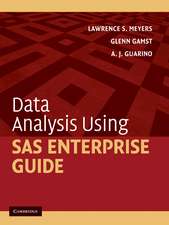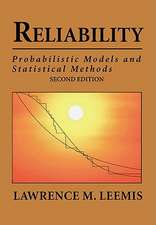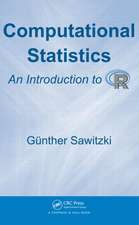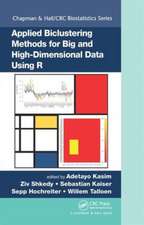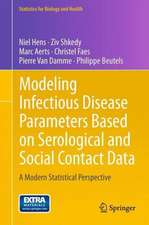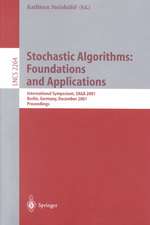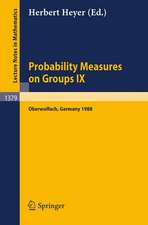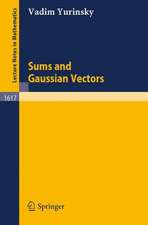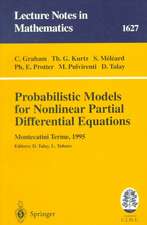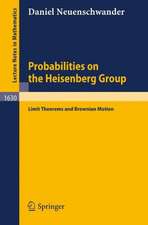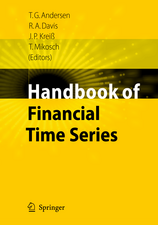Modeling Dose-Response Microarray Data in Early Drug Development Experiments Using R: Order-Restricted Analysis of Microarray Data: Use R!
Editat de Dan Lin, Ziv Shkedy, Daniel Yekutieli, Dhammika Amaratunga, Luc Bijnensen Limba Engleză Paperback – 26 aug 2012
Part I of the book is an introduction, in which we discuss the dose-response setting and the problem of estimating normal means under order restrictions. In particular, we discuss the pooled-adjacent-violator (PAV) algorithm and isotonic regression, as well as inference under order restrictions and non-linear parametric models, which are used in the second part of the book.
Part II is the core of the book, in which we focus on the analysis of dose-response microarray data. Methodological topics discussed include:
• Multiplicity adjustment
• Test statistics and procedures for the analysis of dose-response microarray data
• Resampling-based inference and use of the SAM method for small-variance genes in the data
• Identification and classification of dose-response curve shapes
• Clustering of order-restricted (but not necessarily monotone) dose-response profiles
• Gene set analysis to facilitate the interpretation of microarray results
• Hierarchical Bayesian models and Bayesian variable selection
• Non-linear models for dose-response microarray data
• Multiple contrast tests
• Multiple confidence intervals for selected parameters adjusted for the false coverage-statement rate
All methodological issues in the book are illustrated using real-world examples of dose-response microarray datasets from early drug development experiments.
Din seria Use R!
- 15%
 Preț: 676.86 lei
Preț: 676.86 lei - 17%
 Preț: 362.75 lei
Preț: 362.75 lei - 15%
 Preț: 591.79 lei
Preț: 591.79 lei - 17%
 Preț: 362.16 lei
Preț: 362.16 lei - 17%
 Preț: 461.37 lei
Preț: 461.37 lei -
 Preț: 226.74 lei
Preț: 226.74 lei - 17%
 Preț: 395.94 lei
Preț: 395.94 lei -
 Preț: 374.87 lei
Preț: 374.87 lei - 20%
 Preț: 500.66 lei
Preț: 500.66 lei - 17%
 Preț: 396.92 lei
Preț: 396.92 lei - 15%
 Preț: 360.59 lei
Preț: 360.59 lei - 17%
 Preț: 430.21 lei
Preț: 430.21 lei -
 Preț: 276.09 lei
Preț: 276.09 lei - 15%
 Preț: 497.12 lei
Preț: 497.12 lei - 15%
 Preț: 471.53 lei
Preț: 471.53 lei - 15%
 Preț: 525.35 lei
Preț: 525.35 lei -
 Preț: 489.30 lei
Preț: 489.30 lei - 15%
 Preț: 523.07 lei
Preț: 523.07 lei -
 Preț: 455.89 lei
Preț: 455.89 lei - 15%
 Preț: 518.73 lei
Preț: 518.73 lei - 18%
 Preț: 835.24 lei
Preț: 835.24 lei - 15%
 Preț: 498.94 lei
Preț: 498.94 lei - 18%
 Preț: 783.35 lei
Preț: 783.35 lei - 18%
 Preț: 783.20 lei
Preț: 783.20 lei - 15%
 Preț: 523.91 lei
Preț: 523.91 lei -
 Preț: 484.47 lei
Preț: 484.47 lei -
 Preț: 420.40 lei
Preț: 420.40 lei - 15%
 Preț: 523.07 lei
Preț: 523.07 lei -
 Preț: 419.06 lei
Preț: 419.06 lei - 15%
 Preț: 695.70 lei
Preț: 695.70 lei - 15%
 Preț: 499.12 lei
Preț: 499.12 lei - 15%
 Preț: 493.89 lei
Preț: 493.89 lei - 15%
 Preț: 584.10 lei
Preț: 584.10 lei - 15%
 Preț: 591.47 lei
Preț: 591.47 lei - 15%
 Preț: 497.31 lei
Preț: 497.31 lei - 15%
 Preț: 696.02 lei
Preț: 696.02 lei -
 Preț: 420.02 lei
Preț: 420.02 lei -
 Preț: 489.87 lei
Preț: 489.87 lei - 15%
 Preț: 579.66 lei
Preț: 579.66 lei -
 Preț: 486.42 lei
Preț: 486.42 lei - 15%
 Preț: 507.95 lei
Preț: 507.95 lei -
 Preț: 388.34 lei
Preț: 388.34 lei - 15%
 Preț: 496.67 lei
Preț: 496.67 lei -
 Preț: 423.47 lei
Preț: 423.47 lei - 15%
 Preț: 520.61 lei
Preț: 520.61 lei - 15%
 Preț: 531.26 lei
Preț: 531.26 lei - 15%
 Preț: 576.52 lei
Preț: 576.52 lei -
 Preț: 454.16 lei
Preț: 454.16 lei
Preț: 388.34 lei
Nou
Puncte Express: 583
Preț estimativ în valută:
74.33€ • 80.77$ • 62.48£
74.33€ • 80.77$ • 62.48£
Carte tipărită la comandă
Livrare economică 21 aprilie-05 mai
Preluare comenzi: 021 569.72.76
Specificații
ISBN-13: 9783642240065
ISBN-10: 3642240062
Pagini: 310
Ilustrații: XV, 282 p. 96 illus., 4 illus. in color.
Dimensiuni: 155 x 235 x 20 mm
Greutate: 0.42 kg
Ediția:2012
Editura: Springer Berlin, Heidelberg
Colecția Springer
Seria Use R!
Locul publicării:Berlin, Heidelberg, Germany
ISBN-10: 3642240062
Pagini: 310
Ilustrații: XV, 282 p. 96 illus., 4 illus. in color.
Dimensiuni: 155 x 235 x 20 mm
Greutate: 0.42 kg
Ediția:2012
Editura: Springer Berlin, Heidelberg
Colecția Springer
Seria Use R!
Locul publicării:Berlin, Heidelberg, Germany
Public țintă
GraduateCuprins
Introduction.- Part I: Dose-response Modeling: An Introduction.- Estimation Under Order Restrictions.- The Likelihood Ratio Test.- Part II: Dose-response Microarray Experiments.- Functional Genomic Dose-response Experiments.- Adjustment for Multiplicity.- Test for Trend.- Order Restricted Bisclusters.- Classification of Trends in Dose-response Microarray Experiments Using Information Theory Selection Methods.- Multiple Contrast Test.- Confidence Intervals for the Selected Parameters.- Case Study Using GUI in R: Gene Expression Analysis After Acute Treatment With Antipsychotics.
Recenzii
From the book reviews:
“This edited volume is designed for the analysis of dose-response microarray data in a pharmaceutical environment. … The book includes many useful topics and procedures for graduate students, practitioners, and researchers … in the arena of bioinformatics and statistical bioinformatics. The contributions are written to be accessible to readers with moderate to strong knowledge of statistics, computer science, and biology, since this is a genuine multidisciplinary area.” (S. E. Ahmed, Technometrics, Vol. 55 (3), August, 2013)
“This edited volume is designed for the analysis of dose-response microarray data in a pharmaceutical environment. … The book includes many useful topics and procedures for graduate students, practitioners, and researchers … in the arena of bioinformatics and statistical bioinformatics. The contributions are written to be accessible to readers with moderate to strong knowledge of statistics, computer science, and biology, since this is a genuine multidisciplinary area.” (S. E. Ahmed, Technometrics, Vol. 55 (3), August, 2013)
Notă biografică
Dan Lin holds a Ph.D. in Bioinformatics from Hasselt University, Belgium, where her research focused on the analysis of ‘omics’ data from early drug development experiments. She currently works as a biometrician at Pfizer animal health research and development, where she focuses on discovery and clinical studies for biological and pharmaceutical veterinary products.
Ziv Shkedy is an associate professor for biostatistics and bioinformatics at Hasselt University, Belgium. Dr. Shkedy is a co-author of numerous publications applying statistical methods to infectious diseases data, non-clinical experiments in early drug development and the analysis of microarray and gene expression data. Over the last 15 years, Dr. Shkedy has collaborated with European organizations (ECDC, EMCDDA) on many projects relating to infectious diseases and with pharmaceutical partners on clinical, non-clinical and early drug development projects. He served as an associate editor for Biometrics from 2007 to 2011.
Dr. Yekutieli is Senior Lecturer at Tel Aviv University. He has an M.Sc. and a Ph.D. in Applied Statistics from Tel Aviv University. His research interests include analysis of large-scale data sets, multiple testing and Bayesian analysis. He is currently the Harry W. Reynolds Visiting International Professor at the Wharton school, University of Pennsylvania.
Dhammika Amaratunga is Senior Research Fellow in Nonclinical Statistics at Johnson & Johnson Pharma, where he has been involved in the statistical analysis of high-throughput genomics data since the late 1990s. He and his collaborators have numerous publications and presentations, including a book, “Exploration and Analysis of DNA Microarray and Protein Array Data,” which was one of the first fully authored books on this topic. He is a Fellow of the American Statistical Association. He has a B.Sc. (Hons.) in Mathematics from the University ofColombo (Sri Lanka) and a Ph.D. in Statistics from Princeton University (USA), which he received under the supervision of John W. Tukey.
Luc Bijnens holds M.Sc. and Ph.D. degrees in Biology from the University of Antwerp, Belgium and an M.Sc. in Biostatistics from the University of Hasselt, Belgium. He spent the earlier part of his career in academia at the University of Antwerp, Belgium and Kisangani, Democratic Republic of Congo, and later with Bristol Meyers Squibb and the European Organization of Research and Treatment of Cancer. Luc joined Johnson and Johnson in 1997 as a Statistical Leader for clinical oncology and analgesia, where he was responsible for Durogesic in pain treatment. He also built a non-clinical biostatistics team within J&J that develops statistical methodology and software for R&D. Luc has (co-)authored many publications on statistical methodology. He is a visiting professor at the Center for Statistics of the University of Hasselt and has played a major role in the professional statistics communities in Belgium and Europe, as a society officer (IBS, RSS local groups), conference organizer (NCS2008 in Leuven) and mentor to young people entering the biostatistics profession. He has coached and sponsored several M.Sc. and Ph.D. students with their theses during his career.
Ziv Shkedy is an associate professor for biostatistics and bioinformatics at Hasselt University, Belgium. Dr. Shkedy is a co-author of numerous publications applying statistical methods to infectious diseases data, non-clinical experiments in early drug development and the analysis of microarray and gene expression data. Over the last 15 years, Dr. Shkedy has collaborated with European organizations (ECDC, EMCDDA) on many projects relating to infectious diseases and with pharmaceutical partners on clinical, non-clinical and early drug development projects. He served as an associate editor for Biometrics from 2007 to 2011.
Dr. Yekutieli is Senior Lecturer at Tel Aviv University. He has an M.Sc. and a Ph.D. in Applied Statistics from Tel Aviv University. His research interests include analysis of large-scale data sets, multiple testing and Bayesian analysis. He is currently the Harry W. Reynolds Visiting International Professor at the Wharton school, University of Pennsylvania.
Dhammika Amaratunga is Senior Research Fellow in Nonclinical Statistics at Johnson & Johnson Pharma, where he has been involved in the statistical analysis of high-throughput genomics data since the late 1990s. He and his collaborators have numerous publications and presentations, including a book, “Exploration and Analysis of DNA Microarray and Protein Array Data,” which was one of the first fully authored books on this topic. He is a Fellow of the American Statistical Association. He has a B.Sc. (Hons.) in Mathematics from the University ofColombo (Sri Lanka) and a Ph.D. in Statistics from Princeton University (USA), which he received under the supervision of John W. Tukey.
Luc Bijnens holds M.Sc. and Ph.D. degrees in Biology from the University of Antwerp, Belgium and an M.Sc. in Biostatistics from the University of Hasselt, Belgium. He spent the earlier part of his career in academia at the University of Antwerp, Belgium and Kisangani, Democratic Republic of Congo, and later with Bristol Meyers Squibb and the European Organization of Research and Treatment of Cancer. Luc joined Johnson and Johnson in 1997 as a Statistical Leader for clinical oncology and analgesia, where he was responsible for Durogesic in pain treatment. He also built a non-clinical biostatistics team within J&J that develops statistical methodology and software for R&D. Luc has (co-)authored many publications on statistical methodology. He is a visiting professor at the Center for Statistics of the University of Hasselt and has played a major role in the professional statistics communities in Belgium and Europe, as a society officer (IBS, RSS local groups), conference organizer (NCS2008 in Leuven) and mentor to young people entering the biostatistics profession. He has coached and sponsored several M.Sc. and Ph.D. students with their theses during his career.
Textul de pe ultima copertă
This book focuses on the analysis of dose-response microarray data in pharmaceutical setting, the goal being to cover this important topic for early drug development and to provide user-friendly R packages that can be used to analyze dose-response microarray data. It is intended for biostatisticians and bioinformaticians in the pharmaceutical industry, biologists, and biostatistics/bioinformatics graduate students.
Part I of the book is an introduction, in which we discuss the dose-response setting and the problem of estimating normal means under order restrictions. In particular, we discuss the pooled-adjacent-violator (PAV) algorithm and isotonic regression, as well as the likelihood ratio test and non-linear parametric models, which are used in the second part of the book.
Part II is the core of the book. Methodological topics discussed include:
· Multiplicity adjustment
· Test statistics and testing procedures for the analysis of dose-response microarray data
· Resampling-based inference and use of the SAM method at the presence of small-variance genes in the data
· Identification and classification of dose-response curve shapes
· Clustering of order restricted (but not necessarily monotone) dose-response profiles
· Hierarchical Bayesian models and non-linear models for dose-response microarray data
· Multiple contrast tests
All methodological issues in the book are illustrated using four “real-world” examples of dose-response microarray datasets from early drug development experiments.
Part I of the book is an introduction, in which we discuss the dose-response setting and the problem of estimating normal means under order restrictions. In particular, we discuss the pooled-adjacent-violator (PAV) algorithm and isotonic regression, as well as the likelihood ratio test and non-linear parametric models, which are used in the second part of the book.
Part II is the core of the book. Methodological topics discussed include:
· Multiplicity adjustment
· Test statistics and testing procedures for the analysis of dose-response microarray data
· Resampling-based inference and use of the SAM method at the presence of small-variance genes in the data
· Identification and classification of dose-response curve shapes
· Clustering of order restricted (but not necessarily monotone) dose-response profiles
· Hierarchical Bayesian models and non-linear models for dose-response microarray data
· Multiple contrast tests
All methodological issues in the book are illustrated using four “real-world” examples of dose-response microarray datasets from early drug development experiments.
Caracteristici
This book focuses on the analysis of microarray data in the dose-response setting in early drug development experiments in the pharmaceutical industry Part I discusses the dose-response setting and the problem of estimation of normal means under order restrictions Part II demonstrates the use of the IsoGene R library and in particular its graphical capacity

